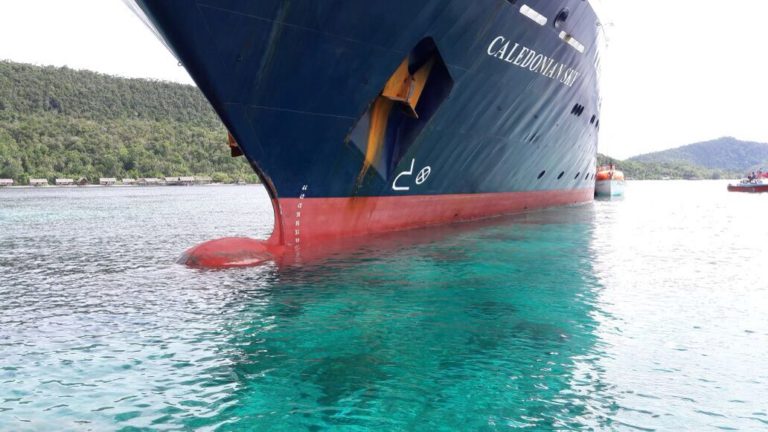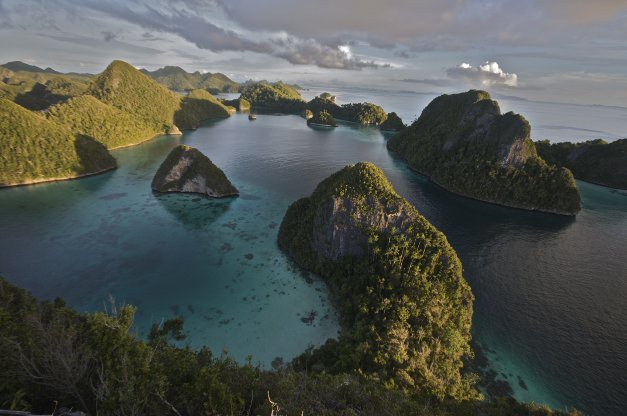- Indonesia has laid out its plan for restoring the damaged reef at Raja Ampat, struck by a cruise ship earlier this year.
- The plan cannot proceed until compensation talks with small ship cruise liner Noble Caledonia’s insurer have concluded.
- The privately held tour operator has pledged to cooperate with Indonesia “towards a fair and realistic settlement.”
- A scientist who assessed the damage said compensation should be higher than normal because of the area’s extreme marine biodiversity, some of the world’s richest.
JAKARTA — The Indonesian government can’t restore one of the country’s best coral reefs until it strikes a compensation deal with the insurer of the cruise line that wrecked it, the deputy coordinating maritime minister said this week.
Raja Ampat, an island chain off the coast of New Guinea, is home to perhaps the world’s richest marine biodiversity. On Mar. 4, the 90-meter-long Caledonian Sky, owned by tour operator Noble Caledonia, ran aground at low tide on a shoal at the Crossover Reef dive site there. Nearly 19,000 square meters (205,000 square feet) of pristine reef were damaged in the accident.
“We already have a design and budget to help revive the area, but we still can’t go in there,” Arif Havas Oegroseno, the deputy coordinating minister, said in an email.

If the government set about restoring the reef, and then negotiations with the insurer broke down and the case went to court, the state could be found guilty of tampering with evidence, he explained.
Noble Caledonia is insured by the London P&I Club. The London-headquartered small ship cruise liner has apologized for the incident and pledged to cooperate with Indonesia “towards a fair and realistic settlement.”
Marine experts suggest that the sooner the damaged reef can be restored, the better its chances for survival.
The placement of artificial corals is imperative to the reef’s recovery, according to Nur Hidayat, marine protected areas monitoring coordinator at Conservation International Indonesia, an NGO. More broadly, though, he argued for minimal human intervention.
“Raja Ampat is one of Indonesia’s ecologically pristine areas that, if left as is without any anthropogenic disruption, has the ability to self-recover, although it will never revive to its pre-accident state,” he said.
In the wake of the accident, the Raja Ampat district administration has prohibited any human activity in or near the area, according to Hidayat.

At least 13,000 square meters of reef were damaged by the 4,290-tonne vessel, according to an official investigation whose results were signed off on by both the state and the tour operator.
The boat also inflicted “medium damage” on 5,612 square meters of reef from sand whipping and coral debris caused by the ship’s movement. A tugboat was called in to break it free from the shallow area, which ultimately harmed the reef even more.
By point of comparison, the broader Raja Ampat Islands stretch across 40,000 square kilometers (15,400 square miles) of land and sea off the northwest tip of West Papua province.
In addition, the incident destroyed the ecosystem’s structural habitat and caused the reduction or loss of diversity of eight coral genera, including acropora, porites, montipora and stylophora.
“Crossover Reef…used to be a perfect example of Raja Ampat’s magnificent marine life,” said Simon Davis, a yachtsman who has explored the islands for three years. “Thick healthy coral covered the entire reef and schools of fish swarmed all over.”
The reef was home to some coral species found only in Raja Ampat, he said. Manta rays and sharks could be spotted cruising its edge.
“Having seen the reef both before and after the crash, the extent of destruction was viscerally shocking. It is tragic that such a stunning place could be reduced to rubble so quickly, and it is terribly sad that it will take decades for it to grow again.”

Ricardo Tapilatu, head of the Research Center for Pacific Marine Resources at the University of Papua, who led a team to assess the damage, said in an interview immediately after the disaster that the standard compensation rate was $200-$400 per square meter.
But due to Raja Ampat’s special biodiversity and its status as one of the world’s most popular dive sites, as well as the fact that the damage occurred in a national park, he added, the rate should be higher than normal.
The Coordinating Ministry for Maritime Affairs is seeking approval to upgrade the status of Raja Ampat — along with four other locations in Maluku, North Maluku and East Nusa Tenggara provinces — to a Particularly Sensitive Sea Area, a designation of the International Maritime Organization (IMO), a UN agency.
The status would give these destinations additional protective actions to control maritime activities in the area, such as routing management and installation of Vessel Traffic Services at nearby ports.
The designation is intended for a sea area that has significance for its “recognized ecological or socioeconomic or scientific reasons and which may be vulnerable to damage by international maritime activities,” according to the IMO.
Banner image: A stingray at Raja Ampat. Photo by Neil Stead/Flickr.
FEEDBACK: Use this form to send a message to the author of this post. If you want to post a public comment, you can do that at the bottom of the page.
